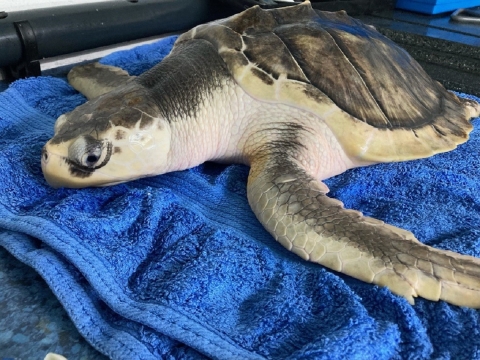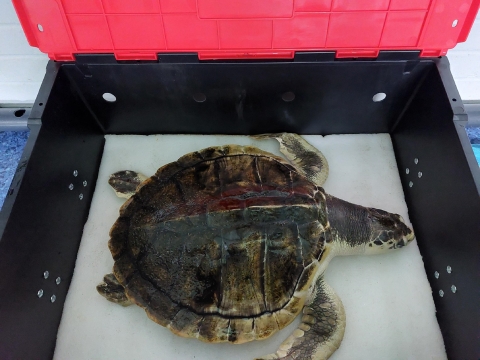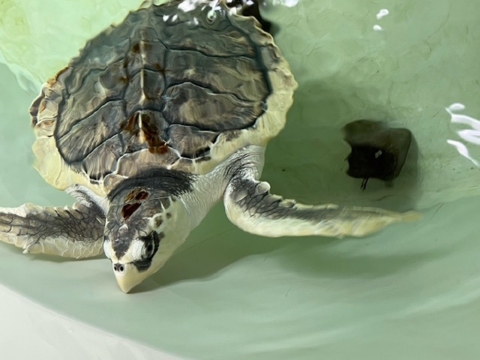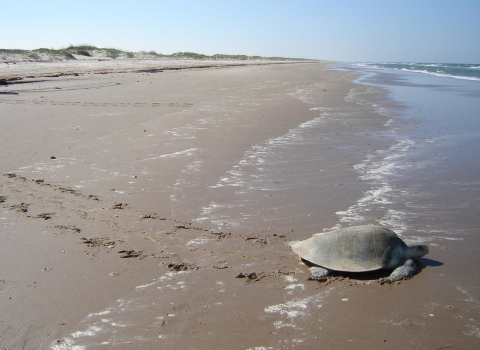In September, the U.S. Fish and Wildlife Service and partners will release a rehabilitated Kemp’s ridley sea turtle named “Tally” from Galveston into the Gulf of Mexico for a second chance at life. Tally was found stranded and near death on the distant shores of Talacre in Northern Wales in 2021.
“The cold waters of the Northeast Atlantic usually result in certain death for this species of subtropical sea turtle in the winter,” said Mary Kay Skoruppa, the U.S. Fish and Wildlife Service’s Texas Sea Turtle Coordinator. “But thanks to the quick response of a great group of international partners and volunteers, Tally is alive and ready to come home.”
Kemp’s ridley sea turtles are the smallest and one of the most endangered species of sea turtles in the world. Though primarily found in the Gulf of Mexico and coastal waters of eastern North America, juvenile Kemp’s ridleys sometimes get swept up in the powerful Gulf Stream and are carried all the way across the Atlantic.
After washing up on the shoreline on the north coast of Wales in November 2021, Tally was spotted by a dog walker and reported as “presumed dead” to the local British Divers’ Marine Life Rescue. The responding biologist from the Anglesey Sea Zoo, Gem Simmons, soon realized Tally was still alive, and along with the director of the zoo, Frankie Hobro, provided months of intensive care until the turtle was healthy again.
With Tally fully recovered, this year an international team decided it is time to come home. But flying an endangered sea turtle between continents is a complex operation.
First, Endangered Species Act (ESA) listed species need more than just a plane ticket and a suitcase to hop between countries. The Convention on International Trade in Endangered Species of Wild Fauna and Flora (CITES) regulates the transport of listed species to ensure that international trade in animals and plants does not threaten their survival in the wild. So before Tally can go anywhere, Skoruppa had to make sure the turtle has a valid CITES import permit in order to clear the Service’s Office of Law Enforcement wildlife inspectors upon arrival in the U.S.
Next, the team had to figure out how to transport Tally back to her home continent. To help with the logistics of the flight, the team reached out to Turtles Fly Too, who partner with the Service and National Oceanic and Atmospheric Administration (NOAA) to coordinate and facilitate aviation in endangered sea turtle relocation efforts. Ken Andrews of Turtles Fly Too described this as their “furthest and most complex mission ever flown.”
Crucially, the Royal Air Force (RAF) stepped up as key partner, greatly assisting in resolving logistical hurdles and generously offering their facilities at RAF Valley and RAF Northolt. Wing Commander Chris Pote of RAF Valley noted the mission’s significance, saying it involved “one of the most endangered of all sea turtles.” Acting Sergeant Beth Roberts added that collaborating on this “worthwhile project” had been a privilege. Thanks to this invaluable partnership and the piloting skills of British Airways Captain Chris Sharp and Tom Baker, Tally and Hobro will be flown home on a commercial flight donated by Turtles Fly Too at the end of August.
Once Tally arrives in the U.S., the turtle will be transferred to the Houston Zoo, where veterinarians will ensure it is healthy enough to be released into the wild. If approved by the Zoo’s veterinarians, researchers from Texas A&M University at Galveston’s Gulf Center for Sea Turtle Research will attach a tracking device to monitor its movements after release.
If all goes well, the international team of partners along with Dr. Donna Shaver, the Texas Sea Turtle Stranding Coordinator from Padre Island National Seashore, are planning to meet in Galveston to celebrate Tally’s release back into the wild in early September.
“An endangered species is one that is at risk of extinction in the near future, so every individual counts,” Skoruppa said. “We are incredibly thankful for all the volunteers and partners who have given Tally a second chance at life; from the dog walker in Wales who reported the turtle, to Turtles Fly Too who are generously flying her back to Texas. We hope that Tally will grow to maturity and return to nest on a Texas beach in a few years to help ensure her species’ survival into the future.”
While Tally’s epic journey is a little unusual, unfortunately stranded sea turtle sightings are not uncommon. In Texas, hundreds of stranded sea turtles are documented by the Sea Turtle Stranding and Salvage Network each year due to cold-stunning, injury and illness.
Anytime a sea turtle is found on a beach or shoreline in Texas, the Service advises the public to quickly report it by calling 1-866-TURTLE-5 (1-866-887-8535).
Partners involved in the effort to rescue, rehabilitate and return Tally to the U.S. include British Divers Marine Life Rescue, Anglesey Sea Zoo, the Royal Air Force, Turtles Fly Too, Houston Zoo, Texas A&M University at Galveston’s Gulf Center for Sea Turtle Research, Padre Island National Seashore, the Texas Sea Turtle Stranding and Salvage Network.






